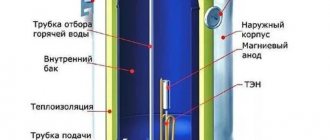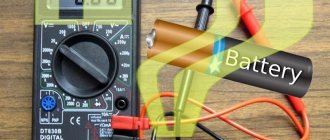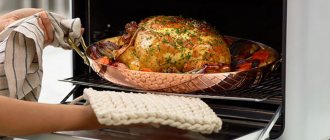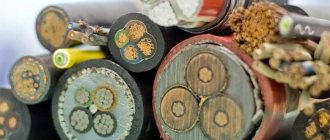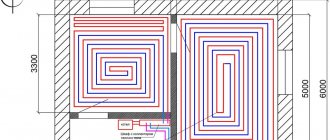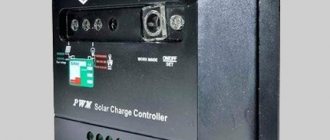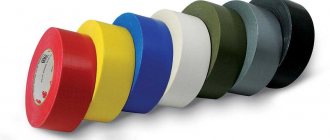A modern kitchen is equipped with cooler electrical equipment than starships in old movies. And it requires a responsible approach to the selection and installation of wiring and electrical installation products.
Let's start with the fact that if you decide to please the owner of the kitchen and install a lot of modern household appliances, both small and large, first take care of the new electrical wiring. To begin with, separate the lighting and power circuits, and then count the amount of equipment and how much the kitchen units will “eat”. Most likely, you will need several supply circuits. In order not to impose formidable rules for households in the style of “do not turn on the washing machine and dishwasher at the same time!”
Remember!!! All high-power kitchen appliances must have a separate power line from the electrical panel.
But if the washing machine can be moved to the bathroom, and not everyone has a dishwasher, then the stove and oven will not disappear from the kitchen. Let's talk about them, or rather about sockets for the hob and oven.
Purpose and design
Any power outlet can be considered an electrical connector. It is structurally provided with contacts that are connected and disconnected. It is thanks to them that consumers are connected to the power grid. Connectors can be single-phase or three-phase. In the latter case, the limiting current parameter will be 380 V.
Among the existing types, plug connectors are the most popular. For the manufacture of power structures, ultra-high quality plastic is used, as can be seen in the photo of power sockets. The material must not only be durable, but also provide resistance to the combustion process.
Additionally, the devices differ in the following properties:
- anti-corrosion protection of metal components;
- protection against penetration of dust, water, moisture, gasoline;
- moisture resistance and preservation of performance over a wide range of temperatures.
In plug-type connectors, the cable that provides the passage of current is secured with a special bracket. It has a round shape and is flexible. Connections are made using tinned copper terminals.
The peculiarity is that the internal contacts are arranged in a standard way; multi-colored wires correspond to different voltage parameters. Therefore, it is quite difficult to make a mistake in connection.
Types of devices
Depending on the characteristics of the electrical network in the house, you can use single-phase or three-phase models. Connectors that have different numbers of contacts are popular, for example:
- ground, phase, zero;
- 3 phases with zero;
- ground, 3 phases and mandatory zero.
Existing types of power sockets allow the use of connectors in portable and stationary versions. Additionally, other device options are highlighted.
Buy a socket for the hob, install it and that’s happiness!
There will undoubtedly be happiness, but one outlet is not enough for it. You will have to make a whole list of components.
Single-phase connection
1. Cable.
For a single-phase network we use a 3x4 or 3x6 cable, brands VVGng (flat, round) or NYM. The cross section is selected according to the power of the equipment.
| VVG, VVGng cable 3x4 | VVG, VVGng cable 3x6 | NYM cable 3x4 | NYM cable 3x6 |
2. Box or socket box.
For wall mounting of an electric stove socket, a cover box is useful. Its characteristics must match those of the socket. That is, if we set it to 20 A, then the box and socket are marked as such. Similarly with 32-amp ones - we take everything the same.
If the installation is internal, for example, in a city apartment or a brick cottage, then a special socket box is needed.
| Leten overhead box for wall mounting of 20A sockets | Leten overhead box for wall mounting of 32A sockets | Batibox for hidden installation of 32A sockets |
Of course, components and sockets for electric stoves are produced not only by Legrand. You can take cheap analogues, but we remind you that skimping on safety is a bad idea.
3. Automatic machines and RCDs.
As already mentioned, each powerful unit of kitchen appliances needs its own connection line to the power supply panel. This means that you will need an automatic machine and an RCD to safely connect the cable and protect against electric shock if it suddenly breaks through to the housing.
The machines are also selected in accordance with the characteristics of the stoves and sockets. For low- and medium-power single-phase cabinets and panels (with a power of up to 4 kW), single-pole circuit breakers are installed at 20 A, for powerful ones (with a power over 4 kW) - at 32 A. They are paired with an RCD, one step higher than the rating of the machine. That is, for a 32 Ampere circuit breaker you need a 40A/30mA RCD. For a 20A machine - RCD 25A/30mA.
| ABB Circuit breaker 1P C20A | ABB Circuit breaker 1P C32A | ABB RCD 2P 25A 30mA | ABB RCD 2P 40A 30mA |
As a result, the diagram for connecting kitchen appliances to the power panel will look something like this.
Connecting kitchen electrical wiring groups to the apartment electrical panel.
Remember!!! A specialist must select components and connect the hob or oven! Incorrect selection is dangerous; incorrect components, unprotected installation and other errors can lead to overheating of the wiring and fire.
Three-phase connection
We would like to pay special attention to three-phase hobs. Before buying such equipment for a city apartment, find out whether it can be connected. Standard wiring in old houses runs at 220 Volts. But in new buildings and private cottages they immediately install a three-phase network at 380 V. You will need your own components for it.
1.Cable.
Three-phase power cable VVGng(A) 5x4 for powerful models from 4 kW or 5x2.5 if the hob has a low power of no more than 4 kW.
| Power cable VVGng(A) 5x4 -0.660 single-wire GOST+ | Power cable VVGng(A) 5x2.5 -0.660 single-wire GOST+ |
2. Automatic machines and RCDs.
You will need a three-pole 32 or 20 Ampere circuit breaker depending on the power of the hob or oven and a four-pole RCD (for a three-phase network). They are selected in the same way, with an excess of one step from the nominal value of the machine. If you chose a three-pole 20A circuit breaker, then you need to take a 25A/30mA RCD. For a three-pole 32A circuit breaker you will need a four-pole 40A/30mA RCD.
| ABB Circuit breaker 3P C20A | ABB Circuit breaker 3P C32A | ABB RCD 4P 25A 30mA | ABB RCD 4P 40A 30mA |
3.Socket box or box.
Depending on how you have to install the connection point: external or internal.
| Leten overhead box for wall mounting of 20A sockets | Leten overhead box for wall mounting of 32A sockets | Batibox for hidden installation of 32A sockets |
A range of sockets for both single-phase and three-phase hobs and ovens can be purchased in our online store.
| Sockets for Leten stove |
Both separately and in pairs. This set is cheaper than buying everything separately.
Installation method
Sockets can be installed openly or hidden. In the first case, the overhead box will be placed directly on the wall. This option is suitable if there is open wiring, which is often found in wooden or damp rooms. Outdoor installation is also possible.
Hidden type devices require preliminary arrangement of a cell inside the wall where the structure will be fixed. The place for the socket box is drilled with a drill with a crown. All wires are located in a channel, which is arranged by gating the walls. Most often in residential buildings and apartments we are faced with this very decision.
Safety precautions
Regardless of what type is used, it is important to remember that all work on connecting the connector to the electrical networks of the facility being operated, and installing the product, must be carried out only by qualified personnel. The specialist works as part of a team, in addition to performing work, after conducting safety instructions and having all the necessary tools and special clothing to carry out such work.
If the work is carried out by unqualified personnel who do not have permission to carry out installation work and without observing all the above conditions, liability in the event of an electrical injury falls directly on the person who carried out the work without obtaining the appropriate permit.
Take care of your life and do not carry out such work yourself, this will ensure your safety not only at the installation stage, but also at the stage of operation of the facility. After all, the work performed by specialists is guaranteed not to fail over time.
Design features
The simplest technological solution is designs designed for alternating current without grounding. Power sockets with grounding have not only holes for a standard plug, but also a special plug that functions as a grounding conductor. It can also be located on the side in the form of contacts.
When using this model, the grounding contacts are connected until the power elements and the plug connectors touch.
The design may include a special protective system. For example, some models have special curtains on the holes for the fork. They only open if two pins go in at the same time. It is convenient to use connectors with built-in ejectors that are activated when you press a button.
Sometimes manufacturers install a special timer on which you can set the time for connecting or opening contacts. Modifications with RCDs do not lose popularity - this is an excellent solution for areas with a high level of responsibility in terms of electrical parameters.
Scope and structure of power sockets
What is a power outlet? This is essentially an electrical connector where there are contacts that can be separated or connected, which provides power to the device. Structurally, single-phase and three-phase connectors are distinguished. The 3-phase current parameter is 380 Volts. Popular among all possible options are plug connectors. Products for this purpose are made from special plastic, which is characterized by strength and good resistance to ignition. Other design features can also be highlighted:
- the presence of corrosion protection for all structural metal elements;
- preventing condensation, dust, water, and flammable mixtures from entering under the housing;
- ability to work over a wide temperature range.
In plug sockets, the cable responsible for the passage of electric current is secured with a flexible bracket. The connection points are equipped with tinned copper terminals. The wires are color-coded, which helps you avoid mistaking the voltage characteristics during the connection process.
Device types
There are several types of power products, the use of which depends on the parameters of the electrical network. Connectors with different numbers of contacts are in high demand:
- zero, ground, phase;
- zero and three phases;
- three phases, zero and ground.
Manufacturers have made sure that power sockets can be used for both mobile and stationary structures. Sockets are distinguished depending on the current value: 25, 32, 63, 125 Amperes. These parameters must be compared with the power consumption of electrical appliances that are to be powered.
Installation options
Electrical accessories can be mounted hidden or open. When attaching a surface-mounted socket, you need to install it on the wall surface. This applies if all electrical wiring is of the open type, such as in bathhouses, utility rooms or wooden residential buildings. Also, such products are suitable for outdoor installation. Hidden type power sockets mean that before mounting you will need to make a recess in the wall. This is where the entire structure is attached, and the wires are laid in a grooved channel. This is the best option for residential premises.
Degree of protection of power connectors
When purchasing, you need to pay attention to resistance to external factors. For this purpose, all products are marked accordingly. For example, IP44 or IP67, where the first of the two digits is the protection against dust, and the second is against moisture. That is, the number 6 means complete dust resistance, and 8 means the highest level of protection from moisture (the ability to work under water).
Design Features
The simplest design is one that is designed for alternating current and does not have grounding contacts. Power sockets with grounding have a special grounding conductor in the form of a plug.
The structure may also contain special protective elements - curtains that block the holes for inserting the plug and open only when the pins are inserted simultaneously. There are also products on sale with a built-in ejector, where there is a button, when pressed, the plug itself flies out of the holes. Trademarks are developing products with timers, where the time for connecting and disconnecting contacts is programmed. More complex options have an RCD in their design, which allows you to reliably protect the network from overloads and accidents.
How to choose a power outlet?
The following parameters must be taken into account:
- The place where the electrical accessories will be installed, as well as the type of wiring and method of its arrangement.
- Rated power.
- Manufacturer, price and quality of the product.
Extensions, splitters, adapters and adapters are often purchased for power connectors. The cable for the power outlet must have good flexibility. If multi-core conductors are used, the prepared contacts should be constantly monitored and their performance assessed.
This page is also searched online for the query: what is a power outlet.
Selection and connection
Before you start connecting a power outlet with your own hands, it is advisable to evaluate how correctly you have chosen the type and type of device.
Several parameters are taken into account:
- Firstly, this is the installation location and features of the electrical wiring, the method of its installation.
- Secondly, it is important to calculate the required denomination.
- Thirdly, the presence of grounding protection.
- Well, fourthly, the cost of the outlet and the quality of its execution.
In addition to power connectors, various accessories are purchased and actively used - extension cords, splitters, child protection devices, adapters and adapters.
Power is first supplied to the connectors and then removed from the plug to the point of consumption. Clamps with screw-type terminals allow for reliable connection of wiring to contacts.
Torque motor: operating principle, main characteristics and advantages- Why do you need a circuit breaker in an apartment?
- Why did my MacBook laptop stop charging?
You can choose a cable for a power outlet with flexible wiring. But if you work with multi-core wiring, then the contacts must be regularly maintained, assessing their condition. Therefore, it is often recommended to replace tinning with tips.
Excessive heating of the contacts should be avoided. To do this, take into account the current rating. Its value is determined by the cross-sectional area of the core and connecting contacts.
Installation and connection
You can connect the socket for an electric stove with your own hands, without using the services of professional electricians. If you have taken into account all the requirements stated in PUE 7 and have chosen the desired type of this device, then you can begin installation.
Photo - connection diagram
Instructions on how to step by step install a socket for a 32 A and 40 A electric stove in a 220 V (1 phase) and 380 V (3 phase) network:
- Both indoor and outdoor models are connected directly via plate terminals. To gain access to them, you need to unscrew the cover on the back of the electrical appliance and remove the protection;
- The connection is made only between contacts of the same color (if color coding is used). For a single-phase network, the phase (red wire) must be connected to the terminals, between which it is advisable to additionally install special jumpers;
- Sometimes, instead of jumpers, loops of wire of a suitable diameter are used, on average it should be more than 6 mm;
- In this case, to install a tap in the 380 power network, it is not necessary to use jumpers. The phase wires are directly connected to the terminals. Make sure that the serial number and color markings match;
- If the plug has a ground pin, the adapter is also connected to ground. To do this, install a ground wire on the top terminal (PE), as in the photo below.
Photo - ground terminal
Also, sometimes situations arise when you need to move an outlet for an electric stove from one place in the house to another. The transfer is carried out in the same way as wiring. You will need a wiring diagram to help you make new holes in the walls. After preparing the opening, you need to remove the wires from the old place and carefully pull them into the new one. It may be necessary to use an additional outlet.
Photo - the principle of connecting contacts
Install a socket box with a Euro socket in a new location and connect it in the same way as in the instructions above.
Installation of a socket for an electric stove
Power socket blocks that are installed to power power-demanding equipment must be selected taking into account high electrical safety parameters.
Standard sockets are rated for a current of 10 or 16A. When connecting a more powerful current, the contacts will heat up. To prevent this from happening, it is necessary to use 32A devices with a short-term load of 40A for power consumption less than 7 kW and 63A if power consumption exceeds 7 kW.
The best solution when connecting an electric stove and other powerful units is three-phase power. If you take 3-phase power sockets, then they will have up to 5 contacts.
- USB socket: instructions for connection and setup. Review of the best manufacturers of USB sockets for the home
- Plug socket: all types and their characteristics. Instructions for correct and quick installation of a plug socket with your own hands
- How to choose wire fasteners - detailed instructions with examples
When figuring out how to install a power socket for a stove, you should opt for an overhead structure using a multi-core copper cable with a cross-section of each core of 3x4 mm. Connection to the connector and plug is made according to the established diagram. The cable must pass through a 40A automatic protective device.
If you are faced with the absence of a grounding loop, then the cable must be “hung” on a special metal structure in the electrical panel. But connection to the metal body of the switchboard or grounding to the neutral wire is not allowed. Contacts must be cleaned and protected from oxidation.
It is recommended to use tinning technology or crimping with a brass sleeve. To prevent oxidation and subsequent short circuiting, all contacts must be firmly secured to prevent overheating.
We come across power connectors all the time. Their installation requires knowledge in the field of electrical engineering. This is especially true for installing sockets for powerful electrical equipment. That is why it is recommended to delegate these functions to specialists.
Types of power sockets
Depending on the conditions of use, installation method, and consumer properties, the following typical versions of 220 volt power connectors are divided:
- Power socket for electric stove. Depending on how many phases are supplied and which plate is connected, three-phase and single-phase options are distinguished. The 25a 220v socket is single-phase.
Power contacts are made of brass. It has three contacts for connecting phase, neutral, and grounding cables. Usually supplied with a power plug;
A variety of connectors used to connect plates, with a body made of bakelite, are labeled as RSh socket.
- The cable socket 20a, intended for power connections, is self-supporting and sealed, has three contacts and is secured using special tools to the end part of the power cable. As a rule, it is equipped with a corresponding plug;
- A 42V socket has two contacts, is designed for a current of up to 10 amperes and does not have grounding. Used to exclude third-party connection to the network. The 42v socket has its own characteristic plug connector, without which it is impossible to connect to it;
- Reinforced 20A socket, allowing you to connect a load equal to the specified indicator.
There are also surface-mounted sockets, hidden-mounted sockets with double and triple connectors, outdoor, sealed, and other types of sockets. Each of the power outlets has the following characteristic differences:
- Maximum permissible current. Can be 10, 16, 20 or 25 amps;
- According to installation options. Flush-mounted, surface-mounted, cable or panel;
- By execution. Not waterproof, protected from splashes, from oblique jets of water and completely sealed;
- By the presence of a grounding contact and protective curtains or a cover covering the connector.
In each specific case, the optimally suitable type of product is used, providing a guaranteed result and operating in accordance with the design loads.
Photos of power outlets
1+
Read here! Electrical sockets
